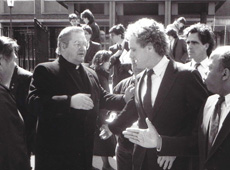Everyone’s destiny in Fianna Fáil’s hands
Posted By: January 24, 2016
Patrick Murphy. Irish News (Belfast).Saturday, January 23, 2016
If you are fully aware of all possible permutations for a coalition government following the forthcoming election in The South, you may need to get out more.
If, however, you are not quite sure what is happening down there, life will be simpler if you focus on just one party. (Think of this as a northerner’s guide to what they get up to on the other side of the border. Chapter 1: Politics.)
That party is Fianna Fáil, the Republican Party. (This distinguishes it from Sinn Féin, which is now two republican parties: left wing in The South and ight wing in The North. Members walking across the bridge from Strabane to Lifford have to learn a whole new vocabulary before they reach the other side.)
Fianna Fáil means ‘soldiers of destiny’, but since no one knows what a soldier of destiny is, it is better left in Irish. Its name occurs in the national anthem: Sinne[we are] Fianna Fáil. Some opposed to the party sing Sinne laochra fáil instead, which means the same thing, but it shows that they are not FF-ers. (That use of language is perfectly normal in the south, so never mind writing to the editor.)
Former party stalwart, the late Brian Lenihan, once described himself as the ‘x’ in “Oxo”, meaning that he could straddle every political fence. Fianna Fáil is the ‘x’ in the Oxo of southern politics. It has a foot in every camp. (No, you may not suggest that when it came to the bank bail-out it had two feet in it. That is all in the past now.)
The party is associated with what is endearingly called the “cute hoorism” of Irish politics. (You need not write to the editor about that one either. It is an everyday sociological term in Ireland to describe the complex relationship between elector and elected. It cannot be directly translated into English, largely because it is English.)
The reason you should focus on Fianna Fáil is that its performance in the election will shape not just the next government, but the next generation of southern politics. While every party’s performance will have some impact on all others, Fianna Fáil will have a pivotal role, because it is the most coalition-friendly party.
Its politics have usually been described as centrist (sort of mid-stream between Lifford and Strabane) and historically it has placed opportunity before ideology. (In most countries politics is a science. In Ireland it is an art, which usually comes under the heading of literature, mainly in the category of satire.)
Party leader, the highly competent Micheal Martin, recently broke with history and said his party was “a bit to the left”, thereby distancing himself from Fine Gael’s austerity policies. (Those of you not fluent in the language of Irish politics should understand that a “bit” is less than a “quare bit” and it is a quare bit smaller than a “whole heap”. All Dáil parties are now “a bit to the left” of Fine Gael.)
Since 1932, Fianna Fáil has been in office for 61 of the 84 years. Following Ireland’s economic collapse, it lost 57 of its 77 Dáil seats in the 2011 election. So can it regain its former glory, or are the soldiers of destiny destined to slide even further?
The party’s excellent performance in the 2014 local elections suggests that it could win up to 35 Dáil seats. Mr Martin’s Ard Fheis speech last weekend focussed on Fine Gael and not Sinn Féin, which he presumably no longer regards as an electoral threat.
(Sinn Féin has delayed its Ard Fheis until after the election. It will be held on April 23, the 100th anniversary of the 1916 Rising. If you must make a comment, please do so quietly.)
As well as the economic arguments, this election is also for the title of Dáil Descendants of 1916. A year ago, Sinn Féin was the favourite. Today Fianna Fáil is ahead. However, if it does not pass the 30-seat mark, its role as the Republican Party will be captured by Sinn Féin. The parties have similar backgrounds. Both abandoned violence against partition in favour of learning to live with it.
Enda Kenny’s speech at today’s Fine Gael Ard Fheis will probably focus on Fianna Fáil, which it sees as its main electoral threat. The more the two parties attack each other, the more likely they are to form the next coalition government.
So keep an eye on Fianna Fáil and you will not just understand the election, you will learn to appreciate the literary art of Irish politics.










